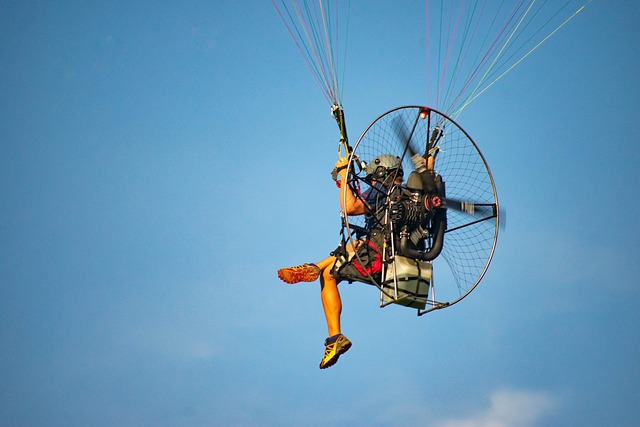Paramotoring, also known as powered paragliding, is an exhilarating and accessible way to experience the thrill of flight. At the heart of any paramotor is the engine, which provides the power to lift the pilot and their equipment into the sky. In this article, I will explore everything you need to know about paramotor engines, from its components and types to choosing the right one for your needs and maintaining it for optimal performance. Whether you are a seasoned pilot or just starting out in the world of paramotoring, this guide will help you gain a deeper understanding of this crucial piece of equipment. So, let’s dive in and explore the world of paramotor engines!
The Components of a Paramotor Engine
A paramotor engine is a complex piece of machinery that requires several components to function properly. Here are the key components of a typical paramotor engine:
- Propeller: The propeller is responsible for converting the engine’s power into forward thrust to move the paramotor forward. It comes in various sizes and shapes, and the right one for you depends on factors such as weight, altitude, and intended use.
- Air Filter: The air filter is responsible for keeping dirt, dust, and other debris from entering the engine and causing damage. It is crucial to keep the air filter clean and in good condition to maintain optimal engine performance.
- Carburetor: The carburetor mixes air and fuel in the right proportions before sending it to the engine for combustion. It plays a crucial role in determining the engine’s performance, especially in terms of power output and fuel efficiency.
- Ignition System: The ignition system is responsible for sparking the fuel-air mixture in the engine’s combustion chamber. It is crucial to have a reliable ignition system to ensure that the engine starts easily and runs smoothly.
- Fuel Tank: The fuel tank stores the fuel needed to power the engine. It comes in various sizes, depending on the engine’s fuel consumption and the intended use.
- Exhaust System: The exhaust system is responsible for removing the engine’s waste gases after combustion. A good exhaust system ensures optimal engine performance and helps to reduce noise levels.
Understanding these components and their role in the functioning of a paramotor engine is essential to choosing the right engine for your needs, maintaining it for optimal performance, and troubleshooting any problems that may arise.
Types of Paramotor Engines
Paramotor engines come in different types, each with its unique characteristics, advantages, and disadvantages. Here are the three most common types of paramotor engines:
- Two-Stroke Engines: Two-stroke engines are the most common type of paramotor engines. They are lightweight, simple, and relatively inexpensive. They have fewer moving parts, making them easy to maintain and repair. However, they tend to consume more fuel, emit more exhaust fumes, and have a shorter lifespan than four-stroke engines.
- Four-Stroke Engines: Four-stroke engines are more efficient, reliable, and durable than two-stroke engines. They consume less fuel, emit fewer exhaust fumes, and have a longer lifespan. However, they are heavier, more complex, and expensive, and require more maintenance than two-stroke engines.
- Electric Motors: Electric motors are the newest type of paramotor engines. They are eco-friendly, quiet, and require minimal maintenance. They are also lighter and more compact than traditional engines. However, they have limited range and power output, and their batteries need frequent recharging.
Choosing the right type of paramotor engine depends on your personal preferences, intended use, and budget. Two-stroke engines are a good option for beginners or those on a tight budget, while four-stroke engines are suitable for experienced pilots or those who prioritize durability and fuel efficiency. Electric motors are ideal for short flights or for those who prioritize eco-friendliness and quiet operation.
Choosing a Paramotor Engine
Choosing the right paramotor engine is crucial for optimal performance and safety. Here four key factors to consider when selecting a paramotor engine:
- Power Output: The power output of an engine determines how much thrust it can produce and how much weight it can lift. The power output is measured in horsepower (HP) or kilowatts (KW). It is essential to choose an engine with sufficient power output to lift you and your equipment safely, especially if you plan to fly at high altitudes.
- Weight: The weight of the engine affects the overall weight of the paramotor and its handling. A heavier engine may provide more power but can make the paramotor less maneuverable and more challenging to transport. It is essential to strike a balance between power and weight to ensure optimal performance and handling.
- Fuel Efficiency: The fuel efficiency of an engine determines how much fuel it consumes per hour of flight. A more fuel-efficient engine can save you money on fuel and allow you to fly longer distances. It is essential to choose an engine with good fuel efficiency without sacrificing power output.
- Price: The price of a paramotor engine varies depending on its type, brand, and features. It is essential to choose an engine that fits your budget without compromising on quality, reliability, or safety. (Here are the top-rated paramotor brands in the market.)
Ultimately, choosing the right paramotor engine requires careful consideration of these factors and your personal preferences and needs. It is recommended to consult with an experienced paramotor pilot or a reputable dealer to help you select the right engine for your paramotor.
Maintaining Your Paramotor Engine
Proper maintenance is essential to keep your paramotor engine running smoothly and safely. Here are some key maintenance tasks to perform regularly:
- Regular Inspection: Regular inspections help to identify any potential problems early on and prevent them from becoming more significant issues. Check for any loose bolts, worn-out parts, or signs of damage, such as cracks or dents. Also, inspect the propeller, air filter, carburetor, ignition system, fuel tank, and exhaust system for any signs of wear or damage.
- Cleaning: Regular cleaning helps to keep your paramotor engine free from dirt, dust, and other debris that can clog the air filter and affect its performance. Use a soft-bristled brush, compressed air, or a damp cloth to remove any dirt or debris from the engine components.
- Lubrication: Lubrication helps to reduce friction and wear on the engine components and extends their lifespan. Apply lubricant to the moving parts, such as the piston, bearings, and crankshaft, as per the manufacturer’s instructions.
- Storage: Proper storage helps to protect your paramotor engine from environmental factors, such as humidity and dust, that can affect its performance and lifespan. Store the engine in a dry and clean place, away from direct sunlight and extreme temperatures. Also, drain the fuel tank and carburetor before long-term storage to prevent fuel from evaporating and causing problems.
Performing regular maintenance tasks and keeping your paramotor engine in good condition is crucial to ensure optimal performance and safety. Consult with the manufacturer’s manual or an experienced mechanic for specific maintenance guidelines and recommended service intervals.
Troubleshooting Your Paramotor Engine
Despite proper maintenance, paramotor engines may develop problems that affect their performance and safety. Here are some common problems and how to troubleshoot them:
Common Problems
- Engine fails to start or runs rough: This could be due to a dirty air filter, fouled spark plug, or a clogged fuel system.
- Engine overheats: This could be due to insufficient lubrication, a dirty air filter, or a faulty ignition system.
- Loss of power: This could be due to a clogged fuel filter, a damaged propeller, or an incorrect carburetor setting.
How to Diagnose Problems?
To diagnose problems, start by checking the obvious things such as fuel level, air filter, and spark plug. Next, check the carburetor settings, fuel filter, and ignition system. If you can’t find any obvious issues, consult an experienced mechanic or the manufacturer’s manual for further guidance.
How to Fix Problems?
The solution to fixing problems depends on the root cause. For example, if the engine fails to start, clean or replace the air filter, replace the spark plug, or check the fuel system for any clogs. If the engine overheats, check the oil level and replace it if needed, clean or replace the air filter, or check the ignition system for any faults. If the engine loses power, check the carburetor settings, replace the fuel filter, or inspect the propeller for any damage.
It is essential to troubleshoot problems promptly and fix them before flying to prevent accidents or damage to the paramotor engine. If you are not confident in your ability to diagnose or fix problems, seek the help of an experienced mechanic or the manufacturer’s technical support.
Safety Considerations
Paramotoring is a thrilling sport that can be enjoyed safely with proper preparation, training, and safety measures. Here are some essential safety considerations for paramotor engine operation:
General Safety Guidelines
- Always wear appropriate safety gear, such as a helmet, eye protection, and a harness.
- Follow proper takeoff and landing procedures, including wind assessment and communication with other pilots.
- Always check the weather forecast and avoid flying in adverse weather conditions.
- Avoid flying over populated areas, airports, or restricted airspace.
- Be aware of and follow local regulations and laws regarding paramotoring.
Pre-Flight Checklist
- Inspect the paramotor engine and all components for any signs of wear or damage.
- Check the fuel level and quality.
- Test the ignition system and carburetor.
- Inspect the propeller and ensure it is securely attached.
- Check the weather conditions and assess wind direction and speed.
In-Flight Safety Measures
- Maintain a safe altitude and distance from other objects, such as trees, buildings, and power lines.
- Avoid abrupt maneuvers or changes in direction.
- Monitor your fuel level and plan your flight accordingly.
- Be aware of any changes in weather conditions and adjust your flight plan accordingly.
Emergency Procedures
- Always have an emergency plan in place, such as a landing zone or a backup engine.
- In case of an engine failure, maintain calm and glide to a safe landing area.
- In case of an emergency landing, use proper landing techniques, such as a flare and a roll.
Remember to always prioritize safety over thrills and stay alert to any potential hazards or risks.
Conclusion
Paramotoring is an exciting and accessible sport that can provide a unique perspective on the world from above. At the heart of any paramotor is the engine, which provides the power to lift the pilot and their equipment into the sky. In this article, we have explored everything you need to know about paramotor engines, including their components, types, choosing the right one, maintaining it for optimal performance, troubleshooting common problems, and essential safety considerations.
Whether you are a seasoned pilot or just starting out in the world of paramotoring, it is crucial to have a deep understanding of the paramotor engine and how to operate it safely and effectively. By following the guidelines and best practices outlined in this article, you can ensure that your paramotor engine runs smoothly, safely, and provides an exhilarating flying experience. So go out, explore the skies, and enjoy the freedom of flight!








